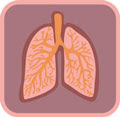a. Teach cigarette smoking cessation
b. Maintaining adequate serum K levels
c. Monitoring pts for signs of hypercapnia
d. Replacing fluids, adequately during hypovolemic states
2. Which ND would be a priority for a pt c ARDS?
a. Ineffective breathing pattern
b. Pain
c. Ineffective health maintenance
d. Risk for infxn
3. Early sign of ARDS in a pt at risk?
a. Elevated CO2 level
b. Hypoxia not responsive to O2
c. Metabolic acidosis
d. Severe, unexplained lyte imbalance
4. pH 7.52, PaO2-50, PaCO2-28, HCO3-24
a. hypoxemia
b. hypoventilation
c. hyperventilation
d. o2 toxicity
5. Same condition as above, which conclusion accurate?
a. Pt severely hypoxic
b. O2 low but poses no risk for pt
c. Pt’s paO2 c/in normal range
d. Pt requires O2 c very low O2
6. same condition, possible cause?
a. COPD
b. DKA c kussmaul’s
c. MI
d. PEmbolus
7. which intervention should the nurse anticipate in a pt c ARDS?
a. Tracheostomy
b. Intermittent positive pressure breathing
c. Mechanical vent
d. Insertion of a chest tube
8. Which condition can put a pt at risk for ARDS?
a. Septic shock
b. COPD
c. Asthma
d. HF
9. which assessment would be most appropriate for determining correct placement of ETT in a mech vent pt?
a. assess skin color
b. monitor RR
c. verify amount of cuff inflation
d. auscultate lung sounds bilaterally
10. which nursing intervention would promote effective airway clearance in a pt c ARD?
a. Administer O2 q 2hrs
b. Turn pt q 4hrs
c. Admin sedatives
d. Sxning if cough ineffective
11. which is a complication associated c mechanical ventilation?
a. GI hemorrhage
b. Immunosuppression
c. Increased CO
d. P Emboli
12. The nurse would anticipate which of the following ABG results in a pt experiencing a prolonged, severe asthma attack?
a. low PaCO2, high PaO2, low pH
b. High paco2, low pao2, low pH
c. High paco2, high pao2, high pH
d. Low paco2, low pao2, high pH
13. A pt’s ABG values are as follows:
pH 7.31, paO2-80, PaCO2-65, HCO3-36
Which s/sx would the nurse expect?
a. cyanosis
b. flushed skin
c. irritability
d. anxiety
Answers in the comments section.


